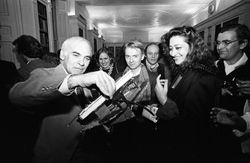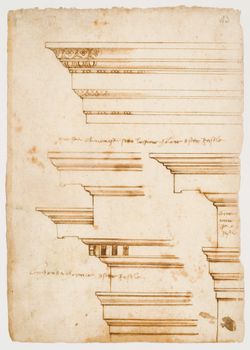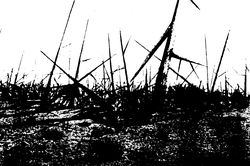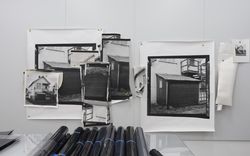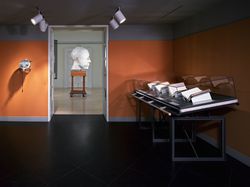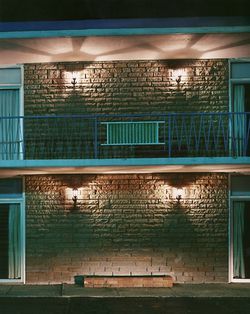Le chercheur en résidence Irene Sunwoo présente sa recherche : Dans les années 1970 et 1980, l’Architectural Association (AA) à Londres a mis à l’essai un modèle d’éducation architecturale « du marché », appuyant un éventail d’études théoriques. Explorant des questions concernant entre autres la politique, la phénoménologie, la sémiotique, la durabilité, la littérature(...)
Maison Shaughnessy
27 juillet 2017, 18h
Séminaire de chercheur en résidence : Irene Sunwoo
Actions:
Description:
Le chercheur en résidence Irene Sunwoo présente sa recherche : Dans les années 1970 et 1980, l’Architectural Association (AA) à Londres a mis à l’essai un modèle d’éducation architecturale « du marché », appuyant un éventail d’études théoriques. Explorant des questions concernant entre autres la politique, la phénoménologie, la sémiotique, la durabilité, la littérature(...)
Maison Shaughnessy
documents textuels
ARCH158357
Description:
Cette chemise contient de la documentation au sujet de la Fondation Frank Lloyd Wright et et de la correspondance diverse de la Fondation Frank Lloyd Wright, adressée à M. et Mme Roger D'Astous, soit à titre d'amis de la Fondation ou à titre d'ancien apprenti du Fellowship, selon le cas. Elle contient également les documents suivants: 6 exemplaires du bulletin Friends of Taliesin : vol. 1, no 1 (avril 1985), no 3 (déc. 1985), vol. 2, no 1 (avril 1986), vol. 4, no 3 (oct. 1988), vol. 5, no 1 (fév. 1989) et no 2 (mai 1989); 1 exemplaire du Taliesin Fellowship news : vol. 1, no 1 (printemps 1988); 1 exemplaire du programme du The Taliesin Festival of Music and Dance qui a eu lieu au Pavillon de Taliesin West en 1968; 1 exemplaire de Arizona Biltmore - History and Guide; 1 exemplaire d'une brochure parue en mai 1953 à l'occasion de l'exposition Small Exhibition of Organic Architecture; 1 exemplaire du catalogue paru vers 1954 lors de la présentation de l'exposition Sixty Years of Living Architecture, à Los Angeles (cette exposition avait d'abord été présentée à Florence en 1951); 1 exemplaire de Bâtiment, vol. 36, no 12 (décembre 1960); 1 exemplaire du The Los Angeles Times Home magazine (9 mars 1969).
Documentation au sujet de la Fondation Frank Lloyd Wright
Actions:
ARCH158357
Description:
Cette chemise contient de la documentation au sujet de la Fondation Frank Lloyd Wright et et de la correspondance diverse de la Fondation Frank Lloyd Wright, adressée à M. et Mme Roger D'Astous, soit à titre d'amis de la Fondation ou à titre d'ancien apprenti du Fellowship, selon le cas. Elle contient également les documents suivants: 6 exemplaires du bulletin Friends of Taliesin : vol. 1, no 1 (avril 1985), no 3 (déc. 1985), vol. 2, no 1 (avril 1986), vol. 4, no 3 (oct. 1988), vol. 5, no 1 (fév. 1989) et no 2 (mai 1989); 1 exemplaire du Taliesin Fellowship news : vol. 1, no 1 (printemps 1988); 1 exemplaire du programme du The Taliesin Festival of Music and Dance qui a eu lieu au Pavillon de Taliesin West en 1968; 1 exemplaire de Arizona Biltmore - History and Guide; 1 exemplaire d'une brochure parue en mai 1953 à l'occasion de l'exposition Small Exhibition of Organic Architecture; 1 exemplaire du catalogue paru vers 1954 lors de la présentation de l'exposition Sixty Years of Living Architecture, à Los Angeles (cette exposition avait d'abord été présentée à Florence en 1951); 1 exemplaire de Bâtiment, vol. 36, no 12 (décembre 1960); 1 exemplaire du The Los Angeles Times Home magazine (9 mars 1969).
documents textuels
Olumuyiwa Adegun, chercheur en résidence 2016, présente ses recherches : Les villes d’Europe au XIXe siècle, à l’instar des villes d’Afrique aujourd’hui, ont souffert de graves problèmes de logement. Les bidonvilles ont marqué Berlin et Paris, tout comme dans les dernières décennies, le logement informel est devenu un trait particulier de Nairobi et de Johannesburg.(...)
Maison Shaughnessy
4 août 2016, 18h
Séminaire de chercheur en résidence : Olumuyiwa Adegun
Actions:
Description:
Olumuyiwa Adegun, chercheur en résidence 2016, présente ses recherches : Les villes d’Europe au XIXe siècle, à l’instar des villes d’Afrique aujourd’hui, ont souffert de graves problèmes de logement. Les bidonvilles ont marqué Berlin et Paris, tout comme dans les dernières décennies, le logement informel est devenu un trait particulier de Nairobi et de Johannesburg.(...)
Maison Shaughnessy
articles
Trajets et transferts
Sous-série
CI001.S2.D5
Description:
Charles Rohault de Fleury was architect for the Muséum national d'histoire naturelle from 1833 to 1862. His work for the Muséum is represented in the CCA collection by a diverse group of prints and drawings. In addition to documenting his built and unbuilt projects, the inclusion of prints and drawings of museum and zoo buildings by other architects record, if only partially, the resources available to Charles in designing his buildings. This reference material provides insight into the influences on Charles' work as well as the nature of the design process itself. His built works, with the exception of the 1854 addition to the greenhouses, are illustrated in a book of prints with a brief accompanying text - "Muséum d'histoire naturelle: serres chaudes, galeries de minéralogie, etc. etc." (published 1837) (DR1974:0002:004:001; a second copy is held by the CCA library) (1). While prints are included for the Galerie de minéralogie et de géologie, the monkey house and the reservoirs, the majority of the prints are of the greenhouses (serres chaudes) begun 1833 (2). Known for their technological innovations in iron construction, these greenhouses utilized the first multi-storey load-bearing cast-iron façades for the central pavilions as well as space frame roof structures and prefabricated parts. This structural system is well documented in the prints in the CCA collection. The design was apparently inspired by the English greenhouses - a plate of which are included in the book - that Charles saw on a tour of England. The use of prestressed beams and curved roofs in the lateral wings attest to this influence. Charles' greenhouses, in turn, influenced the design of other greenhouses in Europe especially those at the Jardins Botanique in Liège and Ghent, Belgium (3). Although Joseph Paxton saw the greenhouses in 1833, it is unclear if they had an impact on the design of the Crystal Palace constructed 1850-1851 (4). The innovations of Charles' greenhouses continued to be acknowledged into the 20th century. Giedion in "Space, Time and Architecture", while erroneously attributing them to Rouhault (5)(6), refers to the greenhouses as "the prototype of all large iron-framed conservatories" (7). In addition to the greenhouses for the Muséum, the CCA collection includes three proposals (dated 1841) for a private greenhouse designed by Charles Rohault de Fleury (DR1974:0002:002:008 - DR1974:0002:002:013). The designs utilize the same curved roofs as the wings of the greenhouses at the Muséum combined with classically detailed stonework. An different aspect of Charles' work for the Muséum national d'histoire naturelle is represented in the album of unexecuted proposals -the only design drawings for the Muséum in the collection - for a Galerie de zoologie (DR1974:0002:024:001-079). Building on the typology of his earlier classical Galerie de minéralogie et de géologie (constructed 1833 -1841), the proposals, which date from between 1838 and 1862, illustrate a gradual enrichment of Charles' classical architectural vocabulary (8). They vary in their spatial configurations and façade treatments ranging from austere colonnaded designs with little ornament to more elaborate ones with richly encrusted facades, complex rooflines and more dramatic interior spaces characteristic of the Second Empire. The majority of the proposals consist of preliminary drawings illustrating the essential formal, spatial and ornamental aspects of the building. One proposal, dated January 1846, is substantially more developed than the others; in addition to general plans, sections and elevations, more detailed drawings are included for the layout of spaces, the elaboration of the facades, the configuration of the structure and even the designs for the specimen display cases. It is also worth noting that this album includes several plans outlining Rohault de Fleury's ideas for the overall development of the Muséum national d'histoire naturelle. In 1846, an album of prints of the Museo di fiscia e storia naturelle in Florence (DR1974:0002:005:001-018) was presented to Charles by the Grand Duke of Tuscany in response to his request for tracings of that building. These prints were probably used as reference material for the design of the new Galerie de zoologie described above. The portfolio of record drawings (ca. 1862) of the zoos in Antwerp, Brussels, Marseille and Amsterdam (DR1974:0002:018:001-027) is probably a dummy for a publication on zoological gardens as well as background documentation for the renovation and expansion of the zoo at the Muséum national d'histoire naturelle in Paris. Both drawings of the facilities for the animals and visitors and general plans of the zoological gardens are included. The Paris zoo project was apparently never undertaken. (1) These prints were reused in the "Oeuvre de C. Rohault de Fleury, architecte" (published 1884) (DR1974:0002:029:001-044). (2) Rohault de Fleury's greenhouses were destroyed in the Prussian bombardments of 1870. The greenhouses, which now stand in their place, are similar in layout and appearance to the original design, but their structural system is different. (3) John Hix, 'The Glass House' (Cambridge, Mass.: The MIT Press, 1981), p. 115. (4) Ibid., p. 115. (5) This error has been repeated by other authors including Henry-Russell Hitchcock, 'Architecture: Nineteenth and Twentieth Centuries' (Baltimore, Maryland: Penguin Books, 1968), p. 120. (6) Leonardo Benevolo, 'History of Modern Architecture' Volume 1: The tradition of modern architecture (Cambridge, Mass.: The M.I.T. Press, 1971), p. 22. (7) Sigfried Giedion, 'Space, Time and Architecture; the growth of a new tradition' (Cambridge: Harvard University Press, 1941), p. 181. (8) Barry Bergdoll, "Charles Rohault de Fleury: Part two: Muséum d'Histoire Naturelle and Studies on analogous Constructions in Europe", 'CCA Research Report", n.d., p. 1.
[1837-ca. 1862]
Muséum nationale d'histoire naturelle
CI001.S2.D5
Description:
Charles Rohault de Fleury was architect for the Muséum national d'histoire naturelle from 1833 to 1862. His work for the Muséum is represented in the CCA collection by a diverse group of prints and drawings. In addition to documenting his built and unbuilt projects, the inclusion of prints and drawings of museum and zoo buildings by other architects record, if only partially, the resources available to Charles in designing his buildings. This reference material provides insight into the influences on Charles' work as well as the nature of the design process itself. His built works, with the exception of the 1854 addition to the greenhouses, are illustrated in a book of prints with a brief accompanying text - "Muséum d'histoire naturelle: serres chaudes, galeries de minéralogie, etc. etc." (published 1837) (DR1974:0002:004:001; a second copy is held by the CCA library) (1). While prints are included for the Galerie de minéralogie et de géologie, the monkey house and the reservoirs, the majority of the prints are of the greenhouses (serres chaudes) begun 1833 (2). Known for their technological innovations in iron construction, these greenhouses utilized the first multi-storey load-bearing cast-iron façades for the central pavilions as well as space frame roof structures and prefabricated parts. This structural system is well documented in the prints in the CCA collection. The design was apparently inspired by the English greenhouses - a plate of which are included in the book - that Charles saw on a tour of England. The use of prestressed beams and curved roofs in the lateral wings attest to this influence. Charles' greenhouses, in turn, influenced the design of other greenhouses in Europe especially those at the Jardins Botanique in Liège and Ghent, Belgium (3). Although Joseph Paxton saw the greenhouses in 1833, it is unclear if they had an impact on the design of the Crystal Palace constructed 1850-1851 (4). The innovations of Charles' greenhouses continued to be acknowledged into the 20th century. Giedion in "Space, Time and Architecture", while erroneously attributing them to Rouhault (5)(6), refers to the greenhouses as "the prototype of all large iron-framed conservatories" (7). In addition to the greenhouses for the Muséum, the CCA collection includes three proposals (dated 1841) for a private greenhouse designed by Charles Rohault de Fleury (DR1974:0002:002:008 - DR1974:0002:002:013). The designs utilize the same curved roofs as the wings of the greenhouses at the Muséum combined with classically detailed stonework. An different aspect of Charles' work for the Muséum national d'histoire naturelle is represented in the album of unexecuted proposals -the only design drawings for the Muséum in the collection - for a Galerie de zoologie (DR1974:0002:024:001-079). Building on the typology of his earlier classical Galerie de minéralogie et de géologie (constructed 1833 -1841), the proposals, which date from between 1838 and 1862, illustrate a gradual enrichment of Charles' classical architectural vocabulary (8). They vary in their spatial configurations and façade treatments ranging from austere colonnaded designs with little ornament to more elaborate ones with richly encrusted facades, complex rooflines and more dramatic interior spaces characteristic of the Second Empire. The majority of the proposals consist of preliminary drawings illustrating the essential formal, spatial and ornamental aspects of the building. One proposal, dated January 1846, is substantially more developed than the others; in addition to general plans, sections and elevations, more detailed drawings are included for the layout of spaces, the elaboration of the facades, the configuration of the structure and even the designs for the specimen display cases. It is also worth noting that this album includes several plans outlining Rohault de Fleury's ideas for the overall development of the Muséum national d'histoire naturelle. In 1846, an album of prints of the Museo di fiscia e storia naturelle in Florence (DR1974:0002:005:001-018) was presented to Charles by the Grand Duke of Tuscany in response to his request for tracings of that building. These prints were probably used as reference material for the design of the new Galerie de zoologie described above. The portfolio of record drawings (ca. 1862) of the zoos in Antwerp, Brussels, Marseille and Amsterdam (DR1974:0002:018:001-027) is probably a dummy for a publication on zoological gardens as well as background documentation for the renovation and expansion of the zoo at the Muséum national d'histoire naturelle in Paris. Both drawings of the facilities for the animals and visitors and general plans of the zoological gardens are included. The Paris zoo project was apparently never undertaken. (1) These prints were reused in the "Oeuvre de C. Rohault de Fleury, architecte" (published 1884) (DR1974:0002:029:001-044). (2) Rohault de Fleury's greenhouses were destroyed in the Prussian bombardments of 1870. The greenhouses, which now stand in their place, are similar in layout and appearance to the original design, but their structural system is different. (3) John Hix, 'The Glass House' (Cambridge, Mass.: The MIT Press, 1981), p. 115. (4) Ibid., p. 115. (5) This error has been repeated by other authors including Henry-Russell Hitchcock, 'Architecture: Nineteenth and Twentieth Centuries' (Baltimore, Maryland: Penguin Books, 1968), p. 120. (6) Leonardo Benevolo, 'History of Modern Architecture' Volume 1: The tradition of modern architecture (Cambridge, Mass.: The M.I.T. Press, 1971), p. 22. (7) Sigfried Giedion, 'Space, Time and Architecture; the growth of a new tradition' (Cambridge: Harvard University Press, 1941), p. 181. (8) Barry Bergdoll, "Charles Rohault de Fleury: Part two: Muséum d'Histoire Naturelle and Studies on analogous Constructions in Europe", 'CCA Research Report", n.d., p. 1.
File 5
[1837-ca. 1862]
Cara Rachele, chercheure en résidence 2016, présente ses recherches: Cette conférence se penche sur l’explosion de dessins détaillés produits pendant la Renaissance. Elle établit le lien entre l’émergence, au XVIe siècle, du détail devenu un canon du dessin et l’évocation de l’antique matériel. L’évolution organique de la façon de dessiner les détails transparaît dans(...)
11 août 2016, 18h
Séminaire de chercheur en résidence : Cara Rachele
Actions:
Description:
Cara Rachele, chercheure en résidence 2016, présente ses recherches: Cette conférence se penche sur l’explosion de dessins détaillés produits pendant la Renaissance. Elle établit le lien entre l’émergence, au XVIe siècle, du détail devenu un canon du dessin et l’évocation de l’antique matériel. L’évolution organique de la façon de dessiner les détails transparaît dans(...)
Peter Galison, professeur Joseph Pellegrino d’histoire des sciences et de physique à l’Université Harvard, parle de son projet actuel, qui combine écriture et film sur les sites de déchets nucléaires et l’avenir des territoires. « Dans leur acception habituelle, les termes “décharge” et “étendue sauvage” sont antinomiques; lorsqu’ils se rejoignent sur les sites abritant(...)
Librairie du CCA
14 février 2010 , 15h
Peter Galison : Étendue sauvage de déchets
Actions:
Description:
Peter Galison, professeur Joseph Pellegrino d’histoire des sciences et de physique à l’Université Harvard, parle de son projet actuel, qui combine écriture et film sur les sites de déchets nucléaires et l’avenir des territoires. « Dans leur acception habituelle, les termes “décharge” et “étendue sauvage” sont antinomiques; lorsqu’ils se rejoignent sur les sites abritant(...)
Librairie du CCA
articles
Quasi documentaire
La vie des documents, la photographie en tant que projet, Stefano Graziani et Bas Princen, Jeff Wall, conversation, histoire orale
5 juin 2023
Piero en tête présente des sculptures contemporaines de l’artiste canado-britannique Geoffrey Smedley, ainsi que 30 livres rares datant du XVe au XVIIIe siècle. Les sculptures de Smedley s’inspirent d’une série de dessins de tête humaine, réalisés par le maître de la Renaissance Piero della Francesca. L’exposition relie ces dessins et les sculptures de Smedley à la(...)
Salle octogonale
2 mai 2001 au 16 septembre 2001
Piero en tête
Actions:
Description:
Piero en tête présente des sculptures contemporaines de l’artiste canado-britannique Geoffrey Smedley, ainsi que 30 livres rares datant du XVe au XVIIIe siècle. Les sculptures de Smedley s’inspirent d’une série de dessins de tête humaine, réalisés par le maître de la Renaissance Piero della Francesca. L’exposition relie ces dessins et les sculptures de Smedley à la(...)
Salle octogonale
Barbara Penner, historienne de l’architecture, retrace l’évolution des Chutes du Niagara, de leur statut de destination phare pour jeunes mariés au XIXe siècle à celui d’icône postindustrielle kitsch, avant de redevenir la destination par excellence des jeunes mariés. Le photographe Alec Soth, dont les travaux constituent l’amorce de cette causerie présentée par Barbara(...)
Théâtre Paul-Desmarais
23 avril 2009
L'enseignement de... Niagara Falls
Actions:
Description:
Barbara Penner, historienne de l’architecture, retrace l’évolution des Chutes du Niagara, de leur statut de destination phare pour jeunes mariés au XIXe siècle à celui d’icône postindustrielle kitsch, avant de redevenir la destination par excellence des jeunes mariés. Le photographe Alec Soth, dont les travaux constituent l’amorce de cette causerie présentée par Barbara(...)
Théâtre Paul-Desmarais
